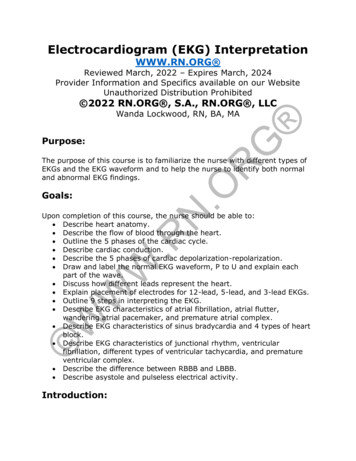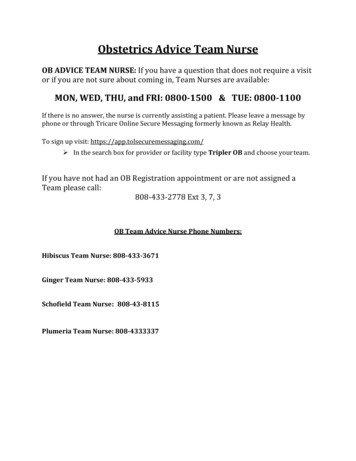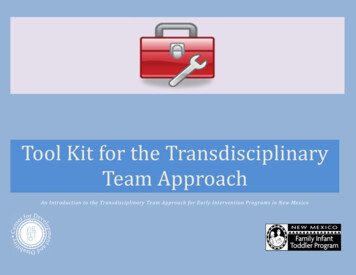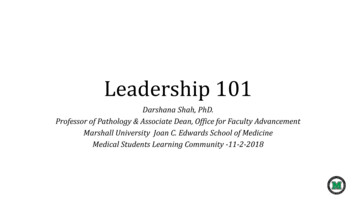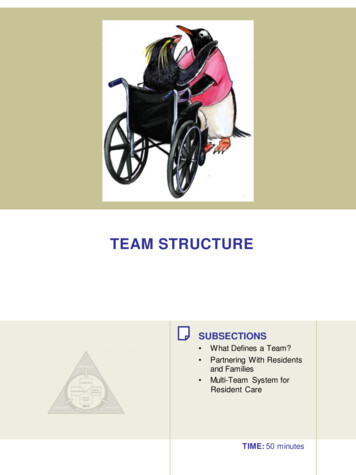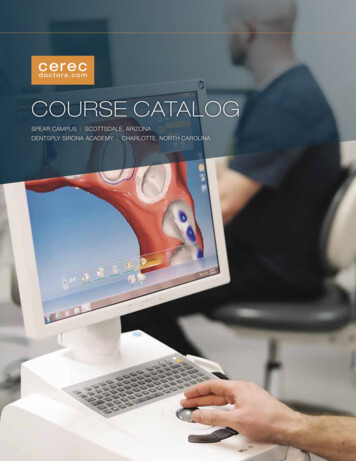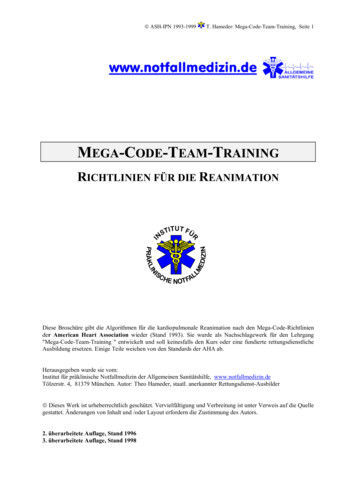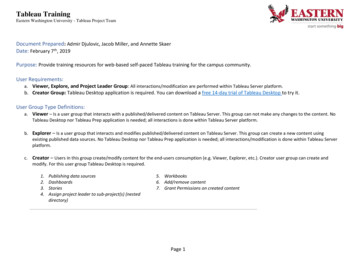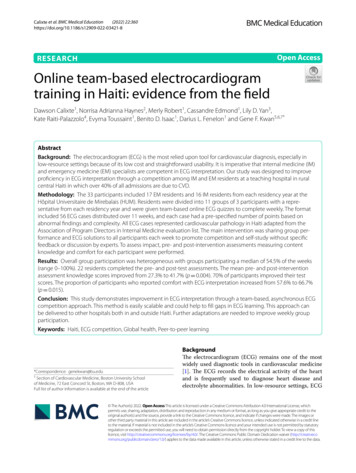
Transcription
(2022) 22:360Calixte et al. BMC Medical 8Open AccessRESEARCHOnline team‑based electrocardiogramtraining in Haiti: evidence from the fieldDawson Calixte1, Norrisa Adrianna Haynes2, Merly Robert1, Cassandre Edmond1, Lily D. Yan3,Kate Raiti‑Palazzolo4, Evyrna Toussaint1, Benito D. Isaac1, Darius L. Fenelon1 and Gene F. Kwan5,6,7*AbstractBackground: The electrocardiogram (ECG) is the most relied upon tool for cardiovascular diagnosis, especially inlow-resource settings because of its low cost and straightforward usability. It is imperative that internal medicine (IM)and emergency medicine (EM) specialists are competent in ECG interpretation. Our study was designed to improveproficiency in ECG interpretation through a competition among IM and EM residents at a teaching hospital in ruralcentral Haiti in which over 40% of all admissions are due to CVD.Methodology: The 33 participants included 17 EM residents and 16 IM residents from each residency year at theHôpital Universitaire de Mirebalais (HUM). Residents were divided into 11 groups of 3 participants with a repre‑sentative from each residency year and were given team-based online ECG quizzes to complete weekly. The formatincluded 56 ECG cases distributed over 11 weeks, and each case had a pre-specified number of points based onabnormal findings and complexity. All ECG cases represented cardiovascular pathology in Haiti adapted from theAssociation of Program Directors in Internal Medicine evaluation list. The main intervention was sharing group per‑formance and ECG solutions to all participants each week to promote competition and self-study without specificfeedback or discussion by experts. To assess impact, pre- and post-intervention assessments measuring contentknowledge and comfort for each participant were performed.Results: Overall group participation was heterogeneous with groups participating a median of 54.5% of the weeks(range 0–100%). 22 residents completed the pre- and post-test assessments. The mean pre- and post-interventionassessment knowledge scores improved from 27.3% to 41.7% (p 0.004). 70% of participants improved their testscores. The proportion of participants who reported comfort with ECG interpretation increased from 57.6% to 66.7%(p 0.015).Conclusion: This study demonstrates improvement in ECG interpretation through a team-based, asynchronous ECGcompetition approach. This method is easily scalable and could help to fill gaps in ECG learning. This approach canbe delivered to other hospitals both in and outside Haiti. Further adaptations are needed to improve weekly groupparticipation.Keywords: Haiti, ECG competition, Global health, Peer-to-peer learning*Correspondence: genekwan@bu.edu5Section of Cardiovascular Medicine, Boston University Schoolof Medicine, 72 East Concord St, Boston, MA D‑808, USAFull list of author information is available at the end of the articleBackgroundThe electrocardiogram (ECG) remains one of the mostwidely used diagnostic tools in cardiovascular medicine[1]. The ECG records the electrical activity of the heartand is frequently used to diagnose heart disease andelectrolyte abnormalities. In low-resource settings, ECG The Author(s) 2022. Open Access This article is licensed under a Creative Commons Attribution 4.0 International License, whichpermits use, sharing, adaptation, distribution and reproduction in any medium or format, as long as you give appropriate credit to theoriginal author(s) and the source, provide a link to the Creative Commons licence, and indicate if changes were made. The images orother third party material in this article are included in the article’s Creative Commons licence, unless indicated otherwise in a credit lineto the material. If material is not included in the article’s Creative Commons licence and your intended use is not permitted by statutoryregulation or exceeds the permitted use, you will need to obtain permission directly from the copyright holder. To view a copy of thislicence, visit http:// creat iveco mmons. org/ licen ses/ by/4. 0/. The Creative Commons Public Domain Dedication waiver (http:// creat iveco mmons. org/ publi cdoma in/ zero/1. 0/) applies to the data made available in this article, unless otherwise stated in a credit line to the data.
Calixte et al. BMC Medical Education(2022) 22:360is often the only or most efficient tool to identify lifethreatening cardiac conditions enabling timely care. Theburden of cardiovascular disease (CVD) is rising exponentially around the world but especially in low- andmiddle-income countries (LMICs) such as Haiti [2, 3].Thus given the strikingly high burden of CVD and thediagnostic value of ECGs, the ability to correctly interpret ECGs is vitally important to the delivery of highquality healthcare [4].As in most countries, ECG interpretation in Haiti is animportant component of undergraduate and postgraduate medical training. Basic ECG interpretation is alsoincorporated into the curricula for trainees in internalmedicine and emergency medicine training programs.The most commonly utilized methods for ECG instruction include didactic lectures and clinical teachingrounds [5, 6]. However, despite these methods, there isa lack of ECG interpretation proficiency among medicaltrainees [4, 7–10]. While in-person teaching remains theeducational gold-standard, there is a dearth of cardiovascular subspecialists and educators in low-resource settings such as Haiti. The ability to provide high quality andconsistent ECG teaching is a significant challenge.The use of virtual learning for the delivery of medicaleducation has become increasingly common especiallyduring the COVID-19 era. Virtual education strategiesallow for flexibility in the timing of delivery of educational content as well as the timing of active participation.In low-resource settings, it may also help address the lackof adequately trained educators. Studies suggest thatusing quizzes to facilitate ECG training via a web basedmodel could be beneficial to trainees [11]. Additionally,Competition Based Learning has been shown to improvestudent motivation and performance in certain settingsand contexts [12]. The use of a competitive, team-based,asynchronous, virtual approach to ECG interpretationeducation in Haiti has not been previously described.Here we present a prospective cohort study evaluating the effectiveness of using a team-based, virtual ECGinterpretation competition strategy to improve ECGinterpretation skills among internal medicine (IM) andemergency medicine (EM) residents at Hôpital Universitaire de Mirebalais (HUM). HUM is one of the largestteaching hospitals in Haiti and is the only one to receiveaccreditation from the Accreditation Council for Graduate Medical Education International [13].MethodsSetting and populationThe Hôpital Universitaire de Mirebalais (HUM) wascreated in partnership between the Ministry of Public Health and Zanmi Lasante/Partners In Health. Thehospital is located in Haiti’s rural Central Plateau andPage 2 of 7delivers acute care services to a broad catchment areawith a population of about 3 million people. HUM offershigh-quality residency training in emergency medicine,internal medicine, general surgery, plastic surgery, pediatrics, obstetrics and gynecology, and neurology.The study was conducted over an 11 week period fromNovember 11, 2019 to January 27, 2020 among IM andEM residents at HUM. Participation in the study wasvoluntary. In total, 33 residents including 16 IM residents and 17 EM residents were recruited for the study.Residents were divided into 11 groups of 3 participants.Groups were formed only within residency training programs. Each group consisted of one resident from eachtraining year: postgraduate year (PGY) 1, 2, and 3. Further, we randomly assigned a unique identification number to each group.This study was reviewed by the institutional reviewboards of Zanmi Lasante and Boston University MedicalCampus and determined to qualify for an exempt determination. All participants reviewed a statement describing this educational research study as exempt.Study designWe administered pretest and posttest evaluations to eachparticipant to assess (1) the learning impact of the competition, and (2) comfort with independent ECG interpretation. We assessed ECG interpretation competencyusing 10 ECG cases with a maximum score of 35 points.The pretest and posttest were identical. We assessedcomfort interpreting ECGs through a 5-point Likertscale: strongly agree to strongly disagree. Secondary outcomes included a change in self-reported comfort withECG interpretation: “I am very comfortable interpreting ECGs”, with answer choices from Strongly Agree toStrongly Disagree (5-point Likert scale). The study designis presented in Fig. 1.Ten ECG cases were administered in both pre-andposttests; 56 ECG cases were distributed over 11 weeks.After the pretest, we conducted the group-basedcompetition intervention. Every week, each groupreceived a web link to access an online folder containing PDF files of 3–5 ECG cases. Each ECG caseincluded a clinical vignette with an image of an ECG,and diagnostic questions. All ECG cases and answersused for the study were selected from the textbookPodrid’s Real-World ECGs, Vol 1–6. Printed copiesof the ECGs were also available. The selected ECGscases were representative of common cardiovascular pathology seen both in the IM wards and the EMdepartment at HUM adapted from the from the Association of Program Directors in Internal Medicineevaluation list. ECG topics included atrial fibrillation,atrial flutter, atrial paced rhythm, atrioventricular
Calixte et al. BMC Medical Education(2022) 22:360Page 3 of 7Fig. 1 Study Design. Figure developed using Visme Software and is our owndelay, mobitz type 1, mobitz 2, complete heart block,bundle branch blocks, ventricular premature complexes, ventricular tachycardia (VT), ventricularfibrillation, ischemia/infarction, and electrolyteabnormalities (Supplementary Material 1). Case difficulty was random with most of the last weeks’ casesbeing hard. For future ECG training, one could recommend to start with easy cases and gradually moveto more difficult cases. The clinical accuracy andappropriateness of the ECG cases and answers wereindependently reviewed by a cardiologist (GFK).Trainees did not receive any specific materials toguide their analysis of the weekly ECG. Traineescould use any available resource including textbooksand web-based content.For the first 2 weeks, each group received 5 ECGcases to test their competency in ECG reading and correctly diagnosing the cases used in the study. Basedon participant feedback that the weekly quizes weretoo long, we decreased the number of ECG cases to3 ECG cases per week for the remainder of the study.In total, we distributed 56 ECG cases. For each case,participants had to select the relevant diagnoses on astandardized answer sheet adapted from the American Board of Internal Medicine Cardiovascular DiseaseCertification Exam (Supplementary Material 2). Eachgroup received a web link to record their answers in anelectronic REDCap database.We classified the ECG cases on a scale from easy tohard based on the learning objectives and the numberof abnormalities. ECGs with more abnormalities hada higher maximum score. The total weekly maximumscores varied from 7 to 20 points. Each ECG abnormality was scored as either correct or incorrect. We did notpenalize participants for incorrect responses and therewas no limit to the number of selected answers for eachECG case. The scores were summed together for eachgroup.
Calixte et al. BMC Medical Education(2022) 22:360Page 4 of 7During the first week of the study, we shared the quizscores of each group to all the teams via email. Afterfeedback from participants revealed that the public posting of each group’s single score was disconcerting toparticipants, we modified the protocol. In the revisedprotocol, only the maximum and the minimum scoresblinded to group identity were sent to each group viaemail to increase motivation and promote engagement.Thus, each group could assess their performance relativeto their peers. After each weekly quiz, we distributed thecorrect responses and detailed descriptions with annotated ECGs to the trainees. Trainees could review thesesolutions independently.Statistical analysisThe primary outcome was a change in individual scoreson the pre- and post-test knowledge assessments. Forcomparison of pre- and post-intervention mean objective assessment scores, a paired 2-sample t-test analysis was performed on the percent correct. Likert scaleanswer choices were used to assess secondary outcomes.For comparison of Likert scale scores, chi square analyseswere performed. Fidelity was determined by the percentof weekly quizzes completed by the groups to determinehigh vs. low participation. Scores across weekly quizzeswere also compared. In all analyses, differences were considered statistically significant when the p-value was lessthan 0.05. Statistical analysis was performed using Statasoftware 12.1.ResultsPre‑ and post‑testA total of 33 residents participated in the study in 11 different groups, 16 internal medicine (IM) and 17 emergency medicine (EM) residents. Baseline characteristicsof the participants are reported in Table 1. 22 residentscompleted both the pretest and posttest, both of whichwere out of 35 total points. The mean pretest score was27.3% [standard deviation 15.6%], while the mean posttest score was 41.7% [sd 24.9%], for a statistically significant increase of 14.4 percentage points [p 0.004](Fig. 2).Weekly quizzesThe participation of groups across weeks ranged fromno participation (0 weeks) among 2 groups to full participation (11 weeks) among 3 groups. 5 groups had lowparticipation ( 5 weeks), while 5 groups had high participation ( 6 weeks). Weekly scores varied greatlyfrom week-to-week, and between groups (Supplementary Material 3).Resident comfort increased over the course of thestudy. Pre-intervention, 57.6% (19/33) of respondentsreported feeling comfortable (Strongly Agree, Agree)interpreting ECGs compared to 66.7% (22/33) post-intervention (p 0.015). There was no significant differencein comfort with ECG interpretation between IM andEM residents post-intervention. Additionally, there wasno significant difference in comfort with ECG interpretation post-intervention based on training year. Despitenot reaching statistical significance, first year residentsdemonstrated a numerically larger improvement inECG interpretation comfort compared to 2nd and 3rdyear residents (Fig. 3). When looking at participation, 6out of 11 groups were higher fidelity groups (defined asgroups that completed greater than 50% of the weeklyquizzes) and they reported feeling more comfortablewith ECG interpretation compared to the 5 lower fidelitygroups, although this difference did not reach statisticalsignificance.DiscussionThis virtual asynchronous ECG competition strategyimproved residents’ ability to accurately interpret ECGs.Seventy percent of participants significantly improvedtheir ECG interpretation scores post-intervention. Inaddition, the study also demonstrated a significantimprovement in residents’ comfort interpreting ECGs.The findings of this study are important given the rising burden of CVD in Haiti, and the diagnostic value ofECGs. Additionally, the findings highlight the value ofinnovative and adaptive teaching methodologies. Studieshave demonstrated that effective teaching and improvement in trainee performance is heavily dependent onTable 1 Participant characteristics and test performanceResidencyEmergency MedicineInternal MedicineResident 1.7%Data for participants with both pre- and post-test results shown. Mean test results shownAll
Calixte et al. BMC Medical Education(2022) 22:360Page 5 of 7Fig. 2 Mean test scores and comfort level with ECG interpretation improve pre- vs. post-intervention. Figure developed using Microsoft Excel anddata are our ownFig. 3 Change in comfort with interpreting ECGs by residency year. Comfort was assessed using a 5-point Likert scale. Positive values indicateimprovement in comfort while negative values indicate reduction in comfort. The difference in comfort level between training years was notstatistically significant (p 0.473). PGY post graduate year. Figure developed using Microsoft Excel and data are our ownusing different and versatile learning styles [11, 14–16].Our team-based ECG competition strategy providedflexibility for learners to access educational materials andlearn at their convenience based on clinical and personalresponsibilities. In this regard, it served as a valuableadjunct to in-person learning. Studies have shown thatweb-based learning strategies, such as the interventionused in this study, are effective at overcoming barriers
Calixte et al. BMC Medical Education(2022) 22:360imposed by distance, time constraints, and resource limitations, and also enable implementation of novel instructional methods [17].We used a very detailed scoring system for ECGanalysis – which the participants were not accustomedto using. A trainee may feel comfortable assessing formajor abnormalities, but not minor ones. Thus, traineesreported relatively high comfort with ECG interpretationat baseline despite relatively low pre-test scores. In ourscoring system, trainees did not earn points for missingeither major or minor abnormalities.Importantly, an element of competition was usedas a motivating factor in this intervention. Studieshave shown that the use of competition and quizzesin teaching interventions can improve motivation andperformance in certain situations [12, 16]. Competition, however, may also increase stress and performance anxiety among some students which may lead toreduced effort and knowledge retention [12, 18]. In thisstudy, while the team-work component of the intervention was well received and facilitated peer-to-peerlearning, the competition element characterized by thepublic display of group scores was not. Through informal feedback, participants expressed concern aboutthe public display of group scores stating that this formof competition invoked stress and embarrassment forsome of the participants. Thus, we adjusted the competition component of the study such that the scores foreach group were not displayed but instead, the highestand lowest scores for each quiz were displayed without reference to any particular group. This modification was important because it continued to motivateparticipants to improve their scores but eliminated thepossibility of identification and by doing so eliminatedassociated stress and embarrassment. With this modification, participants had significant improvements intheir objective and comfort assessments scores demonstrating the efficacy of this web-based ECG competitionintervention.Although the improvement in ECG interpretationfor the study cohort en masse was significant, subgroupanalyses comparing training programs (IM vs. ED) andtraining years (PGY1 vs. PGY2 vs. PGY3), did not demonstrate a statistically significant difference between thegroups. One explanation could be the small sample sizeand lack of power to detect a difference as well as traineedropout. Additionally, six groups met high fidelity criteria defined as participation 6 weeks. Some residentsmay have been dropout and some groups may have hadlow fidelity due to lack of familiarity with REDcap sinceit is a new system that the residents may find difficult tonavigate. Of the 3 PGY2 residents who completed thesurvey, one participant reported less comfort after thePage 6 of 7intervention while the others had no change. This worsening of comfort may be due to low participation amongthis group of residents with very high clinical workload.The low fidelity and dropout may also be a function of areal world application of a voluntary medical educationintervention among physicians-in-training with demanding clinical schedules.This is the first study to assess the efficacy of a webbased ECG competition strategy in improving ECG interpretation proficiency in Haiti. This study is a successfulproof of concept that demonstrates that this web-basedECG competition teaching strategy is feasible and can beeffective. It is also easily scalable and can be incorporatedinto the training of health professions at additional sitesin Haïti and in other LICs.LimitationsLimitations of this study include a small sample size,dropout among residents which may have been due, inpart, to a lack of familiarity with REDcap. Further, lackof a non-intervention group for comparison limits ourability to detect expected improvement in skills over timeamong trainees. Additionally, the improvement in scoresmay, in part, be due to a training effect possibly causedby identical ECGs in pretest and posttest. Our ability toassess the contribution of the team-based nature of theintervention is limited. While we intended for the teamparticipants to work collaboratively each week, we do notknow how the teams functioned. Each residency doeshave regular teaching sessions where trainees can meetface-to-face. However, there could have been one dominant participant from a group, or answers submitted ina non-collaborative manner. Further trainees on off-siterotations may not be able to meet face-to-face.ConclusionThis study demonstrates the feasibility and efficacy of ateam-based, asynchronous competition approach to ECGeducation. Given the success of this pilot, medical educators should consider this strategy in their educationalarmamentarium. Further studies are needed to improveparticipation, assess generalizability, and knowledgeretention.Supplementary InformationThe online version contains supplementary material available at https:// doi. org/ 10. 1186/ s12909- 022- 03421-8.Additional file 1. ECG topics with their level of difficulty.Additional file 2. Quiz Answer sheet.Additional file 3. Weekly quiz score by group.Additional file 4.
Calixte et al. BMC Medical Education(2022) 22:360Page 7 of 7AcknowledgementsWe would like to thank Dr. Philip Podrid for his guidance in this study.6.Authors’ contributionsGFK conceived the study, obtained funding and ethics approval, developedthe protocol and conducted the team-based competition. LY and KR-P ana‑lyzed the data. DC, NH, LY and ET wrote the first manuscript draft. MR, CE, BI,DLF have substantially reviewed the manuscript. All other authors helped todevelop the study, reviewed and interpreted results, revised the manuscript,and approved the final submission.7.FundingGFK was supported in part by the American Heart Association [grant number17MCPRP33460298] and the National Heart, Lung, and Blood Institute [grantnumber K23HL140133]. The funders had no role in the design of the study,conduct, analysis, data interpretation, or in the writing of the manuscript.8.9.10.Availability of data and materialsThe datasets used and/or analysed during the current study are included inthis published article as a supplement (Additional file 4).11.Declarations12.Ethics approval and consent to participateAll methods were carried out in accordance with relevant guidelines andregulations. All experimental protocols were approved by the InstitutionalReview Boards of both Zanmi Lasante IRB (ZLIRB26102028) and Boston Univer‑sity Medical Campus (H-36355).This study was determined to be exempt from review as non-human subjectsresearch by the Institutional Review Boards of both Zanmi Lasante IRB(ZLIRB26102018) and Boston University Medical Campus (H-36355). The needfor informed consent was waived by both institutional review boards.13.Consent for publicationNot applicable.Competing interestsThe authors declare that they have no competing interests.Author details1Zanmi Lasante, Port Au Prince, Haiti. 2 University of Pennsylvania, Philadelphia,PA, USA. 3 Weill Cornell Medicine, New York, USA. 4 Mount Sinai Hospital, NewYork, USA. 5 Section of Cardiovascular Medicine, Boston University Schoolof Medicine, 72 East Concord St, Boston, MA D‑808, USA. 6 Departmentof Global Health and Social Medicine, Harvard Medical School, Boston, MA,USA. 7 Partners In Health, Boston, MA, USA.Received: 13 July 2021 Accepted: 25 April 202214.15.16.17.18.Jorgenson D, Muller A, Whelan AM, Buxton K. Pharmacists teach‑ing in family medicine residency programs. Can Fam Phys.2011;57(9):e341–e346.Sebro NS, Ganapathineedi B, Mehta A. Evolution of ekg reading skills frommedical school to residency. J Am Coll Cardiol. 2019;73(9):3054. https:// doi. org/ 10. 1016/ S0735- 1097(19) 33660-5.Berger JS, Eisen L, Nozad V, et al. Competency in electrocardiogram inter‑pretation among internal medicine and emergency medicine residents.Am J Med. 2005;118(8):873–80. https:// doi. org/ 10. 1016/j. amjmed. 2004. 12. 004.Lever NA, Larsen PD, Dawes M, Wong A, Harding SA. Are our medicalgraduates in New Zealand safe and accurate in ECG interpretation? N ZMed J. 2009;122(1292):9–15.Mahler SA, Wolcott CJ, Swoboda TK, Wang H, Arnold TC. Techniquesfor teaching electrocardiogram interpretation: self-directed learning isless effective than a workshop or lecture. Med Educ. 2011;45(4):347–53.https:// doi. org/ 10. 1111/j. 1365- 2923. 2010. 03891.x.Rolskov Bojsen S, Räder SBEW, Holst AG, et al. The acquisition and reten‑tion of ECG interpretation skills after a standardized web-based ECGtutorial–a randomised study. BMC Med Educ. 2015;15(1):36. https:// doi. org/ 10. 1186/ s12909- 015- 0319-0.DiMenichi BC, Tricomi E. The power of competition: Effects of social moti‑vation on attention, sustained physical effort, and learning. Front Psychol.2015;6. https:// doi. org/ 10. 3389/ fpsyg. 2015. 01282University Hospital in Haiti Earns Global Accreditation as Teaching Institu‑tion. Partners In Health. https:// www. pih. org/ artic le/ unive rsity- hospi tal- haiti- earns- global- accre ditat ion- teach ing- insti tution. Accessed 2 Jun2021.Pourmand A, Tanski M, Davis S, Shokoohi H, Lucas R, Zaver F. Educationaltechnology improves ECG interpretation of acute myocardial infarctionamong medical students and emergency medicine residents. West JEmerg Med. 2015;16(1):133–7. https:// doi. org/ 10. 5811/ westj em. 2014. 12. 23706.Nilsson M, Bolinder G, Held C, Johansson B-L, Fors U, Östergren J. Evalua‑tion of a web-based ECG-interpretation programme for undergraduatemedical students. BMC Med Educ. 2008;8(1):25. https:// doi. org/ 10. 1186/ 1472- 6920-8- 25.Rubinstein J, Dhoble A, Ferenchick G. Puzzle based teaching versustraditional instruction in electrocardiogram interpretation for medicalstudents – a pilot study. BMC Med Educ. 2009;9(1):4. https:// doi. org/ 10. 1186/ 1472- 6920-9-4.Cook D. Web-based learning: Pros, cons and controversies. Clin Med LondEngl. 2007;7:37–42. https:// doi. org/ 10. 7861/ clinm edici ne.7- 1- 37.Ashcraft MH, Kirk EP. The relationships among working memory, mathanxiety, and performance. J Exp Psychol Gen. 2001;130(2):224–37. https:// doi. org/ 10. 1037/ 0096- 3445. 130.2. 224.Publisher’s NoteSpringer Nature remains neutral with regard to jurisdictional claims in pub‑lished maps and institutional affiliations.References1. Antiperovitch P, Zareba W, Steinberg JS, et al. Primary care provider pref‑erences for communication with inpatient teams: one size does not fit all(RL). J Hosp Med. Published online November 8, 2017. doi:https:// doi. org/ 10. 12788/ jhm. 28762. Kwan GF, Jean-Baptiste W, Cleophat P, et al. Descriptive epidemiology andshort-term outcomes of heart failure hospitalisation in rural Haiti. Heart.2016;102(2):140–6. https:// doi. org/ 10. 1136/ heart jnl- 2015- 308451.3. Fene F, Ríos-Blancas MJ, Lachaud J, et al. Life expectancy, death, and dis‑ability in Haiti, 1990–2017: a systematic analysis from the Global Burdenof Disease Study 2017. Rev Panam Salud Pública. 2020;44:1. https:// doi. org/ 10. 26633/ RPSP. 2020. 136.4. Fisch C. Evolution of the clinical electrocardiogram. J Am Coll Cardiol.1989;14(5):1127–38. https:// doi. org/ 10. 1016/ 0735- 1097(89) 90407-5.5. Salerno SM, Alguire PC, Waxman HS. Competency in Interpretation of12-Lead Electrocardiograms: A Summary and Appraisal of PublishedEvidence. Ann Intern Med. 2003;138(9):751-60. https:// doi. org/ 10. 7326/ 0003- 4819- 138-9- 20030 5060- 00013.Ready to submit your research ? Choose BMC and benefit from: fast, convenient online submission thorough peer review by experienced researchers in your field rapid publication on acceptance support for research data, including large and complex data types gold Open Access which fosters wider collaboration and increased citations maximum visibility for your research: over 100M website views per yearAt BMC, research is always in progress.Learn more biomedcentral.com/submissions
Ten ECG cases were administered in both pre-and-posttests; 56 ECG cases were distributed over 11 weeks. After the pretest, we conducted the group-based competition intervention. Every week, each group received a web link to access an online folder con-taining PDF files of 3-5 ECG cases. Each ECG case included a clinical vignette with an image .
